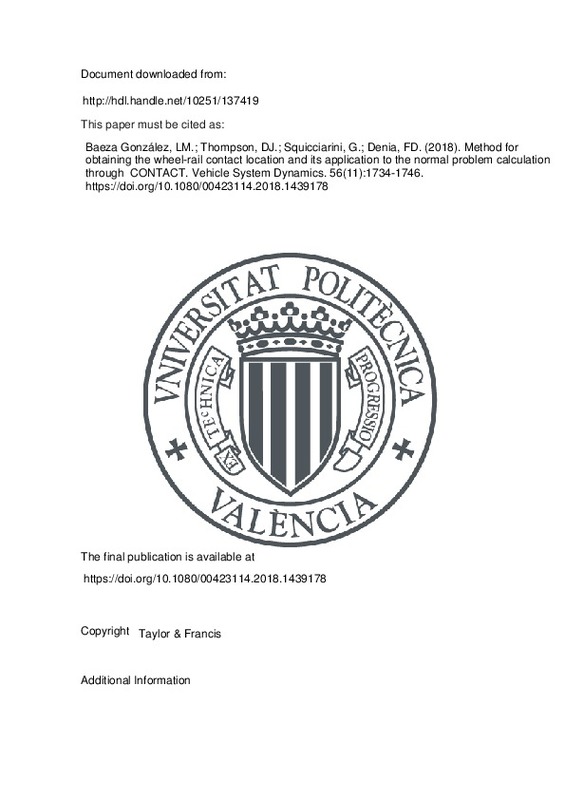Garg, V. K., & Dukkipati, R. V. (1984). Wheel–Rail Rolling Contact Theories. Dynamics of Railway Vehicle Systems, 103-134. doi:10.1016/b978-0-12-275950-5.50009-2
Wickens, A. H. (1965). The dynamic stability of railway vehicle wheelsets and bogies having profiled wheels. International Journal of Solids and Structures, 1(3), 319-341. doi:10.1016/0020-7683(65)90037-5
DE PATER, A. D. (1988). The Geometrical Contact between Track and Wheelset. Vehicle System Dynamics, 17(3), 127-140. doi:10.1080/00423118808968898
[+]
Garg, V. K., & Dukkipati, R. V. (1984). Wheel–Rail Rolling Contact Theories. Dynamics of Railway Vehicle Systems, 103-134. doi:10.1016/b978-0-12-275950-5.50009-2
Wickens, A. H. (1965). The dynamic stability of railway vehicle wheelsets and bogies having profiled wheels. International Journal of Solids and Structures, 1(3), 319-341. doi:10.1016/0020-7683(65)90037-5
DE PATER, A. D. (1988). The Geometrical Contact between Track and Wheelset. Vehicle System Dynamics, 17(3), 127-140. doi:10.1080/00423118808968898
Yang G. Dynamic analysis of railway wheelsets and complete vehicle systems (PhD thesis). Delft: Delft University of Technology; 1993.
Negretti, D. (2012). A third-order approximation method for three-dimensional wheel–rail contact. Vehicle System Dynamics, 50(3), 431-448. doi:10.1080/00423114.2011.595804
Shabana AA, Zaazaa KE, Escalona JL, et al. Modeling two-point wheel/rail contacts using constraint and elastic-force approaches. In: Paidoussis MP, editor. ASME 2002 International Mechanical Engineering Congress and Exposition; 2002 Nov 17–22; New Orleans, Louisiana: American Society of Mechanical Engineers, Rail Transportation Division (Publication) RTD, p. 35–50.
Netter, H., Schupp, G., Rulka, W., & Schroeder, K. (1998). NEW ASPECTS OF CONTACT MODELLING AND VALIDATION WITHIN MULTIBODY SYSTEM SIMULATION OF RAILWAY VEHICLES. Vehicle System Dynamics, 29(sup1), 246-269. doi:10.1080/00423119808969563
Pombo, J., Ambrósio, J., & Silva, M. (2007). A new wheel–rail contact model for railway dynamics. Vehicle System Dynamics, 45(2), 165-189. doi:10.1080/00423110600996017
Polach, O. (2010). Characteristic parameters of nonlinear wheel/rail contact geometry. Vehicle System Dynamics, 48(sup1), 19-36. doi:10.1080/00423111003668203
Santamaría, J., Vadillo, E. G., & Gómez, J. (2006). A comprehensive method for the elastic calculation of the two-point wheel–rail contact. Vehicle System Dynamics, 44(sup1), 240-250. doi:10.1080/00423110600870337
Cuperus, J. L., & Venter, G. (2016). Numerical simulation and parameterisation of rail–wheel normal contact. Proceedings of the Institution of Mechanical Engineers, Part F: Journal of Rail and Rapid Transit, 231(4), 419-430. doi:10.1177/0954409716631009
Chollet, H., Sébès, M., Maupu, J. L., & Ayasse, J. B. (2013). The VOCO multi-body software in the context of real-time simulation. Vehicle System Dynamics, 51(4), 570-580. doi:10.1080/00423114.2013.768771
Pascal, J.-P., & Soua, B. (2016). Solving conformal contacts using multi-Hertzian techniques. Vehicle System Dynamics, 54(6), 784-813. doi:10.1080/00423114.2016.1161201
Piotrowski, J., & Chollet, H. (2005). Wheel–rail contact models for vehicle system dynamics including multi-point contact. Vehicle System Dynamics, 43(6-7), 455-483. doi:10.1080/00423110500141144
Vollebregt EAH, Weidemann C, Kienberger A. Use of “CONTACT” in multi-body vehicle dynamics and profile wear simulation: initial results. in: S. Iwinicki (Ed.) 22nd International Symposium on Dynamics of Vehicles on Roads and Tracks (IAVSD2011), Manchester: Manchester Metropolitan University; 2011.
Liu, B., Bruni, S., & Vollebregt, E. (2016). A non-Hertzian method for solving wheel–rail normal contact problem taking into account the effect of yaw. Vehicle System Dynamics, 54(9), 1226-1246. doi:10.1080/00423114.2016.1196823
Kalker, J. J. (1990). Three-Dimensional Elastic Bodies in Rolling Contact. Solid Mechanics and Its Applications. doi:10.1007/978-94-015-7889-9
Pombo, J., & Ambrosio, J. (2005). A computational efficient general wheel-rail contact detection method. Journal of Mechanical Science and Technology, 19(S1), 411-421. doi:10.1007/bf02916162
Kaiser, I., & Popp, K. (2006). Interaction of elastic wheelsets and elastic rails: modelling and simulation. Vehicle System Dynamics, 44(sup1), 932-939. doi:10.1080/00423110600907675
Falomi, S., Malvezzi, M., & Meli, E. (2011). Multibody modeling of railway vehicles: Innovative algorithms for the detection of wheel–rail contact points. Wear, 271(1-2), 453-461. doi:10.1016/j.wear.2010.10.039
Meli, E., Magheri, S., & Malvezzi, M. (2011). Development and implementation of a differential elastic wheel–rail contact model for multibody applications. Vehicle System Dynamics, 49(6), 969-1001. doi:10.1080/00423114.2010.504854
Burgelman N. The wheel–rail contact problem in vehicle dynamic simulation, in: Railahead Group [PhD thesis]. Technische Universiteit Delft; 2016.
Ren, Z., Iwnicki, S. D., & Xie, G. (2011). A new method for determining wheel–rail multi-point contact. Vehicle System Dynamics, 49(10), 1533-1551. doi:10.1080/00423114.2010.539237
Yang, X., Gu, S., Zhou, S., Zhou, Y., & Lian, S. (2015). A method for improved accuracy in three dimensions for determining wheel/rail contact points. Vehicle System Dynamics, 53(11), 1620-1640. doi:10.1080/00423114.2015.1066508
Johnson, K. L. (1985). Contact Mechanics. doi:10.1017/cbo9781139171731
European Standards, Railway applications – testing for the acceptance of running characteristics of railway vehicles – testing of running behaviour and stationary tests, in: EN 14363:2005.
[-]







![[Cerrado]](/themes/UPV/images/candado.png)


